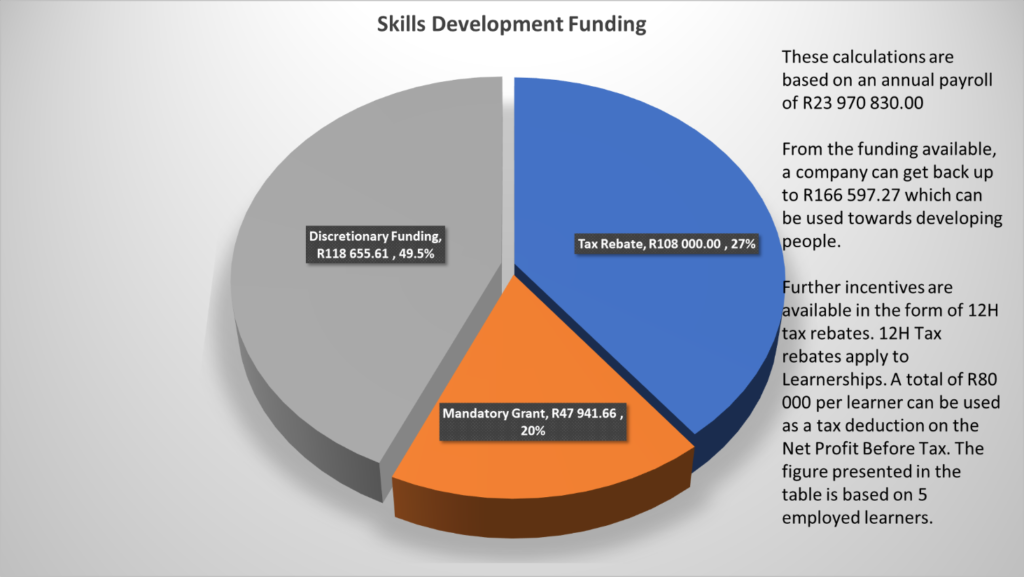Training is defined as a process where people receive skills, attitudes, knowledge, and values in an organized manner.
Why train? The purpose of training is to improve the performance of individuals in their respective jobs and tasks. Training may either be aimed at improving the trainee’s performance at their current position of employment or providing them with skills and knowledge to empower and prepare them for promotions.
It is essential for an organisation to train its employees as it provides the employees with opportunities to expand on their knowledge and to improve their work expertise. It improves the productivity within the organisation as a lot more employees will have confidence in carrying out their duties. The company might incur costs due to training the staff but there is assistance provided by the relevant SETA for compliant companies and tax rebates available.
Benefits of training
1.It indicates to the employee that they are valued, therefore initiating a sense of assurance.
Providing opportunities to upskill and gain career-relevant knowledge, to an employee, indicates to the employee that they are valued. This assurance boosts the overall morale, performance, and productivity of the employee.
2. It improves skills and knowledge.
The benefits of training employees are to expand on their knowledge and expertise. Training is a very important tool if done consistently to improve knowledge and skills.
3. Increased productivity and performance
Training helps employees become better orientated and acquainted with the organisation and its culture, therefore creating self-motivation for the employee to be more productive.
4. Improved service offering to consumers.
When training is done continuously within the organisation, it helps the staff to be more confident in carrying out their duties. This reinforces the positive culture within the organisation which will then have a greater impact on how staff service the customers. Customers will be satisfied as the culture and standard of service will be consistent.
5. Positive Culture within the business
As they say, “the only thing in the world which is consistent is change”. The best way to ensure that your staff is equipped for the ever-changing technology, is to improve their efficiency and effectiveness. Giving your staff the opportunity to undergo training to get the exposure to the latest technology will assist with this.
6. Decreased learning time.
When an individual is trained in an organized fashion, the time that it would have taken to learn the skill and acquire the knowledge is decreased. This also ensures that the employee is correctly equipped.
7. Training helps employees solve operational problems.
When employees are effectively trained, they can identify issues in the workplace and solve them as individuals.
8. Training provides direction.
Trained employees are equipped with the knowledge of the standards of their duties and have a direction on what to do, how to do it, and the acceptable level of performance.
9. Decreased labour turnover.
Employees who are trained have a greater understanding and appreciation of their responsibilities and their contribution to the organisation. Improved job satisfaction decreases staff turnover.
10. Less supervision
Managers and supervisors will spend less time on training-on-the-job and supervising performance as employees are aware of the organization’s expectations of them.
11. Cost benefits to company
The health and safety in the organization will improve, reducing the risks of avoidable accidents. There will also be a decrease in waste. These factors will benefit the variable costs of the company.
12. Addresses South Africa’s imbalances.
Unskilled and semi-skilled individuals in South Africa can be trained and equipped. This contributes to improving the skills imbalances of South Africa and opens opportunities for employment in organisations as employees are trained and promoted.
13. Employees benefit personally.
Employees can receive higher wages and salaries, they can be promoted and allocated more satisfying jobs while also being more marketable in what they have been trained in.
14. Improved company image
Training programmes which are well organised create a positive image for the culture that will make shareholders more likely to invest in the company. Potential employees will be more likely to apply for employment in the company, making recruitment easier. Overall, an organization with trained employees and training programs is more recommendable.
Forms of training
Training could be classroom-based (in-house or public courses) or could be digital (allowing for flexibility). Training can be digitised in the following ways:
- Videos of live training sessions
- Training guides in book forms.
- Audio descriptive training
The above-mentioned ways of digitising training are just a few of the most popular and most effective forms of recording training. When training is recorded it ensures that information shared during training can be saved for future reference as the trainees may need to revert to the knowledge shared in future practical scenarios to ensure that they implement the skill and knowledge learnt effectively, therefore reducing the possibility of mistakes that may be costly.
Digitising training empowers the employer to train as they can use the training material to onboard new employees in the organization without requiring the trainer or coach to be physically present to train. If training sessions are not recorded, the employer faces the risk of high training costs.
Employers and employees will have a shared understanding of the performance standards and how performance must be rated, creating fair requirements of the employees while also reducing the risk of performance-based discrimination.
Employers will be able to evaluate and monitor the effectiveness of training with the use of recorded training used as training material and reference. This means that performance appraisals marking sheets and scores can be formulated around the training material.
Recording training ensures that the standards, requirements as well as the procedures have a reduced risk of being manipulated. Without recording training there is no training material which means that trainees and employers that were previously trained by facilitator become the sole beholders of the skills and knowledge to be passed over to onboarded employees. This will lead to the skills, knowledge, and values, initially taught by the facilitator having a higher risk of being compromised and losing authenticity and relevance.
When training is recorded it turns into training material. An organization that has training material, especially that which has already been taught to currently employed employees benefits from having documented best practices established. Best practices ensure that there is consistency throughout the company, and this creates a culture of acceptable performance.
Training material also improves compliance as the employers and employees can revert to the material derived from previous training to establish and monitor compliance.
Lastly, the training material can help employers differentiate the roles and responsibilities of employers and the expectations of their duties.
All employees with annual payroll’s above R500 000 per annum can benefit from SETA funding if they comply with the Skills Development Act. The following example if based on a medium-size company with 50 – 100 employees.

For more information on the above topic, please contact LabourNet Eastern Cape at 041-373 2994.
Not yet a LabourNet client, but would like to know more about our service and products?
Email us: Phikolomzi Malamlela at pmalamlela@labournet.com or Robert Niemand at robertn@labournet.com
Visit our website at www.labournet.com

